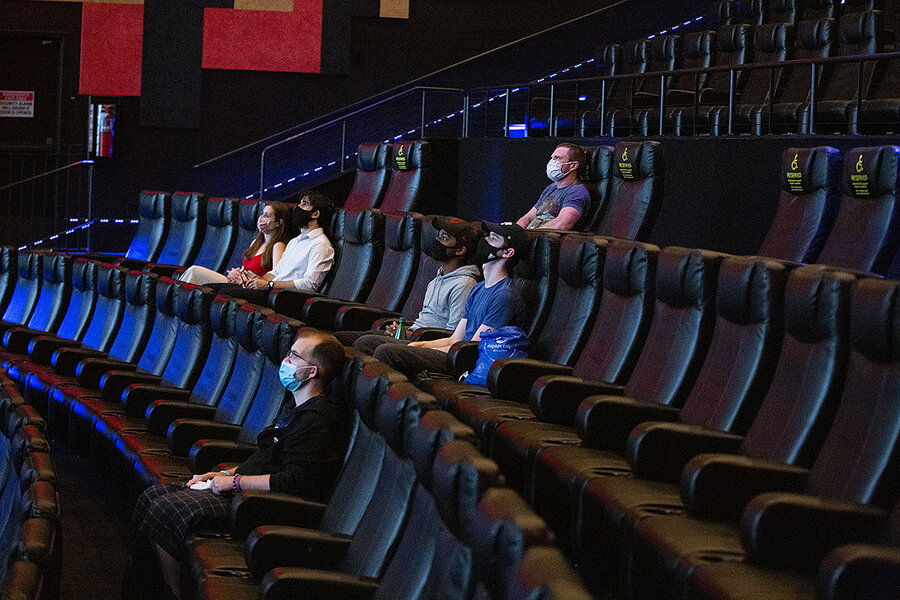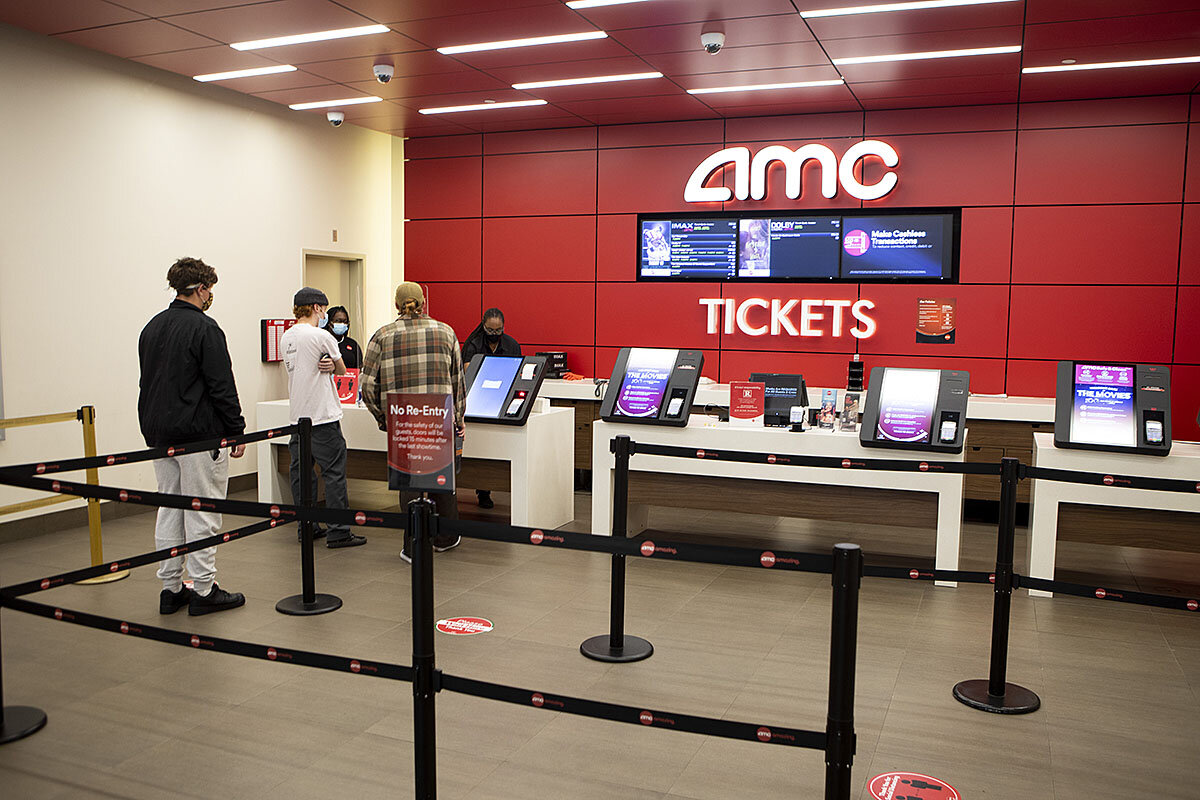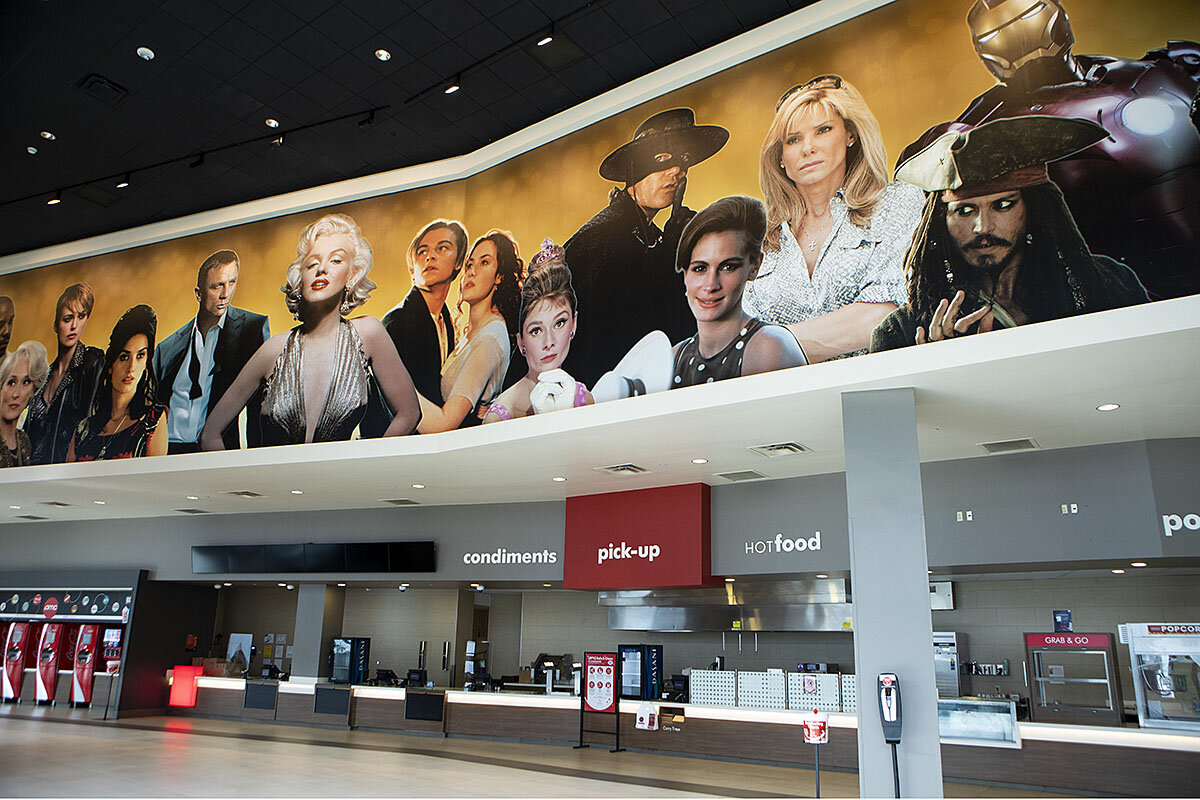Movies bring us together. But should we get used to viewing them apart?
Loading...
| Boston
Theaters in the U.S. are hoping that “Tenet,” a science fiction thriller opening on Thursday, will remind viewers that a cinematic spectacle is best viewed on the largest screen possible.
The public’s drift away from theaters may last past the pandemic and its closure of gathering places, pop culture experts say. Now accustomed to Hollywood releasing films straight to streaming services and video on demand – think "Mulan," arriving Friday on Disney+ – audiences may encourage studios to sometimes bypass cinemas altogether.
Why We Wrote This
Very little can replace the collective laugh or gasp in a theater as a movie unfolds. But how might that experience be evolving – with streaming splintering our attention and a pandemic closing cinema doors?
While this feels like a further erosion of shared cultural experiences, experts say that, thanks to technology, physical proximity isn’t the only means of sharing communal experiences. They champion the variety and creativity sparked by multiple platforms.
“We have discovered that our creative possibilities as a nation, as a society, and the world are so vast that the future from that sense looks bright,” says Timothy Burke, a cultural historian at Swarthmore College in Pennsylvania. “We are not going to run out of things worth seeing together and apart.”
For Duane Miller, seeing the blockbuster “Tenet” on Monday was a kind of homecoming.
Anticipating his first big-screen outing in six months, the film buff says even the elevator ascent to the AMC South Bay Center 12 in Boston was exhilarating. The only thing missing was the smell of popcorn – state pandemic regulations still prohibit concessions – and a regular audience. Due to social distancing, the sold-out late afternoon show included just 25 masked viewers scattered about the 241-seat IMAX auditorium – and an eerily quiet lobby.
“It’s not the same feeling, you know, as when you see it the first time with a bunch of people,” says Mr. Miller, founder and host of the “Cinemania World” podcast. “A crowd environment makes the moment better because, like, when I saw ‘Avengers: Endgame’ for the first time, that crowd was crazy. I saw ‘Endgame’ in theaters eight times.”
Why We Wrote This
Very little can replace the collective laugh or gasp in a theater as a movie unfolds. But how might that experience be evolving – with streaming splintering our attention and a pandemic closing cinema doors?
Shared experiences at the movies may diminish in the wake of the pandemic, as Hollywood releases more films straight to streaming services and video on demand and people partake of debuts in a new way (consider “Mulan,” arriving on Disney+ tomorrow). The sidelining of big-screen entertainment comes at a time when music and sports venues remain shuttered to crowds, too. But some pop culture watchers say that thanks to technology, physical proximity isn’t the only way for people to share culture. By some accounts, pop culture has never been more diverse, dynamic, and available for people to connect with.
“The trend is towards fragmentation and towards a reduced number of universal experiences,” says Peter Suderman, a features editor and film reviewer at Reason magazine who just wrote an article titled “A Summer Without Summer Movies.” “There may be some downsides to that, but there is an upside as well. There’s so many more things out there for us to watch and look at and experience. And they are more likely to be individually tailored towards our particular interests and niches and desires.”
Movie theaters are hoping that Christopher Nolan’s “Tenet,” a science fiction story as nonlinear as an M.C. Escher illustration, will remind viewers that the communal setting of a big screen is still the optimal way to experience a high-octane blockbuster. Its car chase scene, in which vehicles drive in reverse on a busy highway, would make even Dale Earnhardt Jr. flinch.
That movie, which officially opens today, and the few other new releases could play for months on end given that there’s less in the pipeline from Hollywood. Even before the pandemic, multiplex fare was increasingly action-oriented and targeted at creating shared experiences mainly for the demographic most likely to go to the theater: men under the age of 25. Now, comedies, romances, and midbudget movies such as “The Old Guard” starring Charlize Theron, Tom Hanks’ “Greyhound,” and “Eurovision Song Contest: The Story of Fire Saga” with Will Ferrell are more likely to premiere on Netflix, Amazon, and Apple TV+.
Anne Thompson, who writes the blog “Thompson on Hollywood” for Indiewire, says that you can’t easily replace a theater experience, and the shared response and empathy you feel watching a movie. “That is how a movie like ‘12 Years a Slave’ can have an impact on a culture. ... Because that movie became an Oscar contender and ultimately an Oscar winner, everyone had to see it and then share that experience and understand what those characters went through.”
Due to the limited seating in theaters, it will be a while before they can fully meet the demand to view the current movies that are available. That’s reminiscent of an earlier era when the original “Star Wars” played in single-screen theaters for an entire year. And it echoes Steven Spielberg’s prediction in 2013 that movies may become like Broadway plays – just a couple of spectacular big-screen events playing on a screen for a whole season.
“It’s possible that Mr. Spielberg will be right in the long run, but I think that’s a long way off,” says Mark Gill, producer of the Russell Crowe thriller “Unhinged,” which was the first major new release to debut in reopened theaters. He says the pandemic has accelerated the trend toward Hollywood often bypassing the big screen for the small one. “What happens going forward,” he says, “is [studios] will still make some films for theaters, but less of them, and they probably will mostly be the bigger ones.”
For millennia, shared cultural experiences depended upon physical proximity. But the arrival of electronics introduced new forms of communal gatherings. Radio broadcasts created a sense of national cohesiveness and unity. Television kindled a new kind of family hearth. As people began talking about the shows they watched, it created a strong community outside the home, says Paul Levinson, a professor of communication and media studies at Fordham University in New York. With each new technological advancement, it’s the sharing of information that has created a sense of community.
“The World Wide Web has greatly expanded and accelerated this process,” says Mr. Levinson. “The watching of movies online in our COVID age is just another part of this evolution.”
One advantage of home-viewing: You don’t have to worry about kids in the back row pelting the audience with Jujubes. Another is the sheer variety of specialty options available on a proliferation of platforms. Mr. Suderman points to Starz, with its app and cable channel, as an example of a company that produces stories for minority viewers and women over age 25, audiences that bigger Hollywood studios don’t regularly serve. Meanwhile, fans of art house movies can access rich libraries available from companies such as the Criterion Channel and Grasshopper Film.
Some cultural observers suggest that the sense of community created during a two-hour movie is more fleeting than what can be experienced at home, where technology is capable of facilitating richer connections with strangers and acquaintances. When a community is online, it’s often easy to find out more information about others, discovering common interests and perspectives that help deepen relationships. But the decline of in-person communities doesn’t mean the end of them. Seeking out interpersonal contact is still a fundamental part of humanity.
For that reason, theaters aren’t going to completely disappear, says Mike S. Ryan, who has produced art house movies such as Amy Adams’s breakout movie “Junebug” and director Todd Solondz’s “Palindromes.” Some may become even more communal.
“I believe that we are going to eventually, soon return to the Cinema Club situation that we had in the ’60s, where people are able to gather together in small clubs to show films that do not exist on streaming and thus it will be like live music or a singular experience,” says Mr. Ryan, who now teaches at Emerson College in Boston. “I think that eventually that might go to a subscription model,” much like the season tickets people buy for some live theater companies, he says.
The sheer plenitude of options can often feel overwhelming to consumers. But unlike earlier decades, constrained by a narrow band of available media, there’s more opportunity now for the misfits, the outliers, and overlooked talent to find an outlet and create fresh communities. Case in point: the thousands of user-made viral videos on TikTok.
“We have discovered that our creative possibilities as a nation, as a society, and the world are so vast that the future from that sense looks bright,” says Timothy Burke, a cultural historian at Swarthmore College in Pennsylvania. “We are not going to run out of things worth seeing together and apart.”
Editor’s note: As a public service, we have removed our paywall for all pandemic-related stories.










